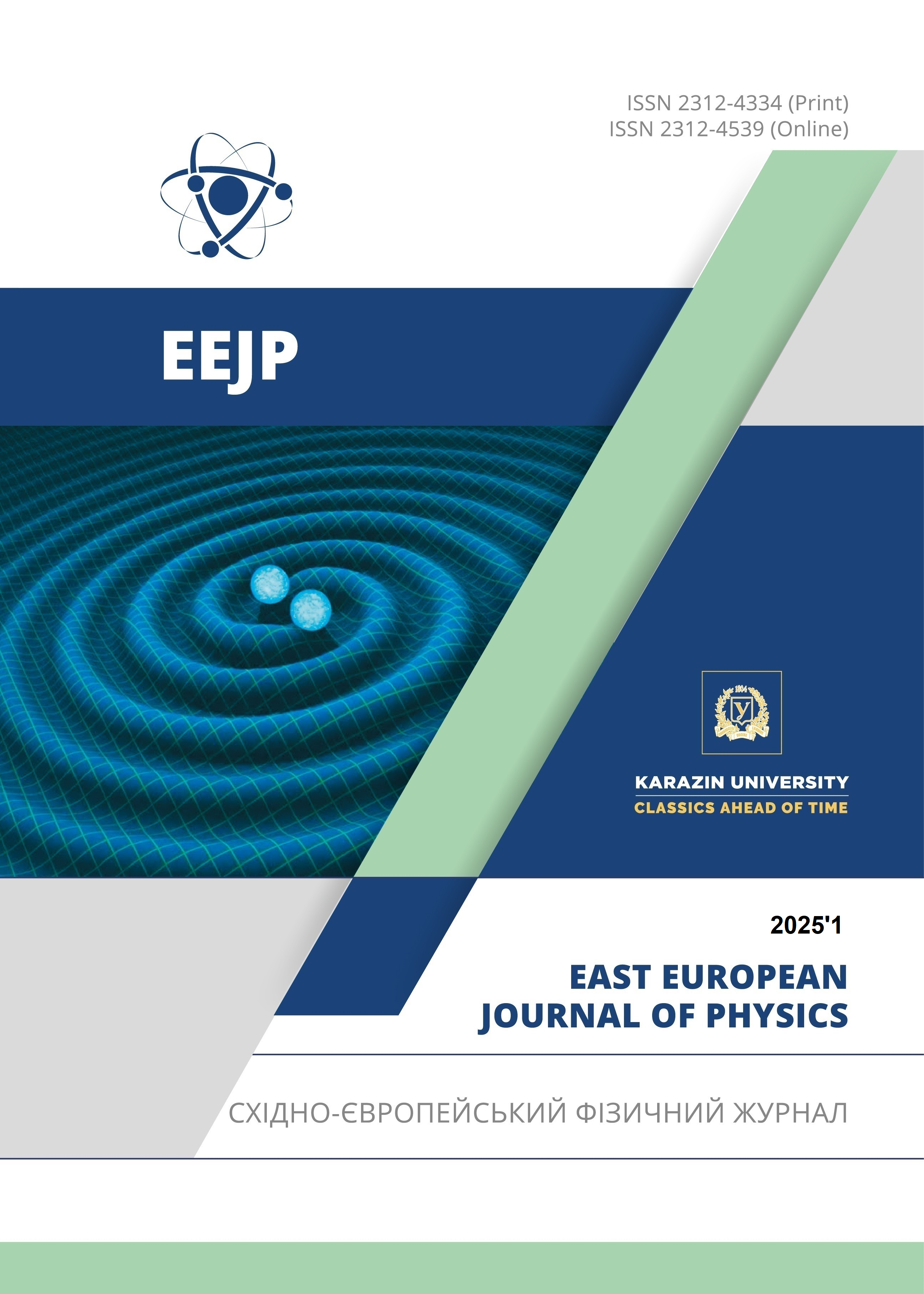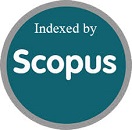Космологiчна модель FLRW iз квадратичною функцiональною формою у f(R, T) теорiї гравiтацiї
Анотація
У цiй роботi дослiджується просторово однорiдний та iзотропний плоский всесвiт Фрiдмана-Лемаˆiтре-Робертсона-Уокера (FLRW) у контекстi гравiтацiї f(R, T), представленої Harko, et al., [Phys. Rev. D, 84, 024020 (2011)]. У цiй роботi розглядається функцiональна форма f(R, T) = f1(R) + f2(T) з f1(R) = R + λ1R2 i f2(T) = 2λ2T де λ1 i λ2 довiльнi константи, R i T є скаляром Рiччi та слiдом тензора енергiї напруги Tij вiдповiдно. Ми представляємо нову космологiчну модель у рамках гравiтацiї f(R, T) , дослiджуючи динамiку Всесвiту FLRW через точне рiшення рiвнянь гравiтацiйного поля. Використовуючи iнновацiйний анзац для параметра Хаббла, H = α (1 + 1/t) , де α — додатна константа, ми фiксуємо еволюцiйну iсторiю Всесвiту. Цей пiдхiд забезпечує природний шлях для дослiдження ключових космологiчних параметрiв, таких як масштабний фактор, параметр уповiльнення, ривок, стрибок, параметри lerk та енергетичнi умови, вiдкриваючи iнтригуючу iнформацiю про динамiку розширення Всесвiту. Ми також обговорюємо дiагностику вимiрювача стану. Нашi результати пропонують глибше
розумiння космiчної еволюцiї в рамках f(R, T) гравiтацiї.
Завантаження
Посилання
Riess, A. G., Filippenko, A. V., Challis, P. et al., Observational evidence from supernovae for an accelerating universe and a cosmological constant, Astron. J. 116, 1009 (1998), https://doi.org/10.1086/300499
Perlmutter, S., Aldering, G., Valle, M. D., Deustua, S., Ellis, R. S., Fabbro, S., Fruchter, A. et al., Discovery of a supernova explosion at half the age of the Universe, Nature 391, 51 (1998), https://doi.org/10.1038/34124
Perlmutter, S., Aldering, G., Goldhaber, G. et al., Measurements of Ω and Λ from 42 high-redshift supernovae, Astrophys. J. 517, 565 (1999), https://doi.org/10.1086/307221
Bennett, C. L., Halpern, M., Hinshaw, G. et al., First-Year Wilkinson Microwave Anisotropy Probe (WMAP)* Observations: Preliminary Maps and Basic Results, Astrophys. J. Suppl. Ser. 148, 1 (2003), https://doi.org/10.1086/377253
Bennett, C. L., Larson, D.,Weiland, J. L. et al., Nine-YearWilkinson Microwave Anisotropy Probe (WMAP) Observations: Final Maps and Results, Astrophys. J. Suppl. Ser. 208, 20 (2013), https://doi.org/10.1088/0067-0049/208/2/20
Spergel, D. N., Verde, L., Peiris, H. V. et al., First Year Wilkinson Microwave Anisotropy Probe (WMAP) Observations: determination of cosmological parameters, Astrophys. J. Suppl. Ser. 148, 175 (2003), https://doi.org/10.1086/377226
Spergel, D. N., Bean, R., Doré, O. et al., Three-yearWilkinson Microwave Anisotropy Probe (WMAP) observations: implications for cosmology, Astrophys. J. Suppl. Ser. 170, 377 (2007), https://doi.org/10.1086/513700
Hinshaw, G. et al., Nine year wilkinson microwave anisotropy probe observations: cosmological parameter results, Astrophys. J. Suppl. Ser. 208, 19 (2013), https://doi.org/10.1088/0067-0049/208/2/19
Tegmark, M., Strauss, M. A., Blanton, M. R. et al., Cosmological parameters from SDSS and WMAP, Phys. Rev. D 69, 103501 (2004), https://doi.org/10.1103/PhysRevD.69.103501
Caldwell, R. R., Doran, M., Cosmic microwave background and supernova constraints on quintessence: Concordance regions and target models, Phys. Rev. D 69, 103517 (2004), https://doi.org/10.1103/PhysRevD.69.103517
Huang, Z.−Y., Wang, B., Abdalla, E., Su, R.−K., Holographic explanation of wide-angle power correlation suppression in the Cosmic Microwave Background Radiation, J. Cosmo. Astropart. Phys. 5, 013 (2006), https://doi.org/10.1088/1475-7516/2006/05/013
Zwicky, F., The redshift of extragalactic nebulae, Helvetica Physica Acta, 6, 110 (1933), https://doi.org/10.48550/arxiv.1711.01693
Carroll, S.M., Duvvuri, V., Trodden, M., Turner, M.S., Is cosmic speed-up due to new gravitational physics ?, Phys. Rev. D 70, 043528 (2004), https://doi.org/10.1103/PhysRevD.70.043528
Harko, T., Lobo, F. S. N., Nojiri, S., Odintsov, S. D., f(R, T) gravity, Phys. Rev. D 84, 024020 (2011), https://doi.org/10.1103/PhysRevD.84.024020
Brans, C., Dicke, R. H., Mach’s Principle and a Relativistic Theory of Gravitation, Phys. Rev. D 124, 925 (1961), https://doi.org/10.1103/PhysRev.124.925
Ferraro, R., Fiorini, F., Modified teleparallel gravity: Inflation without an inflaton, Phys. Rev. D 75, 084031 (2007), https://doi.org/10.1103/PhysRevD.75.084031
Carroll, S.M., Felice, A.D., Duvvuri, V., Easson, D.A., Trodden, M., Turner, M.S., Cosmology of generalized modified gravity models, Phys. Rev. D 71, 063513 (2005), https://doi.org/10.1103/PhysRevD.71.063513
Jiménez, J. B., Heisenberg, L., Koivisto, T., Coincident general relativity, Phys. Rev. D 98, 044048 (2018), https://doi.org/10.1103/PhysRevD.98.044048
Bamba, K. et al., Finite-time future singularities in modified Gauss-Bonnet and F(R,G) gravity and singularity avoidance, Eur. Phys. J. C 67, 295 (2010), https://doi.org/10.1140/epjc/s10052-010-1292-8
Xu, Y., Li, G., Harko, T., Liang, S., f(Q, T) gravity, Eur. Phys. J. C 79, 708 (2019), https://doi.org/10.1140/epjc/s10052-019-7207-4
Houndjo, M. J. S., Reconstruction of f(R, T) gravity describing matter dominated and accelerated phases, Int. J. Mod. Phys. D, 21, 1250003 (2012), https://doi.org/10.1142/S0218271812500034
Bhattacharjeea, S. and Sahoo, P. K., Redshift Drift in f(R, T) Gravity, New Astron. 81, 101425 (2020), https://doi.org/10.1016/j.newast.2020.101425
Pradhan, A., Goswami, G., Rani R., Beesham, A., An f(R, T) gravity based FLRWmodel and observational constraints, Astronomy and Computing 44, 100737 (2023), https://doi.org/10.1016/j.ascom.2023.100737
Starobinsky, A. A., A new type of isotropic cosmological models without singularity, Phys. Lett. B 91, 99 (1980), https://doi.org/10.1016/0370-2693(80)90670-X
Zubair, M., Noureen, I., Evolution of axially symmetric anisotropic sources in f(R, T) gravity, Eur. Phys. J. C 75, 265 (2015), https://doi.org/10.1140/epjc/s10052-015-3496-4
Zubair, M., Noureen, I., Bhatti, A.A., Abbas, G., Shear-free condition and dynamical instability in f(R, T) gravity, Eur. Phys. J. C 75, 323 (2015), https://doi.org/10.1140/epjc/s10052-015-3547-x
Sahoo, P.K., Moraes, P. H. R. S., Sahoo, P.,Wormholes in R2-gravity within the f(R, T) formalism, Eur. Phys. J. C 78, 46 (2018), https://doi.org/10.1140/epjc/s10052-018-5538-1
Sahoo, P.K., Moraes, P. H. R. S., Sahoo, P., Bishi, B. K., f(R, T) = f(R) + λT gravity models as alternatives to cosmic acceleration, Eur. Phys. J. C 78, 736 (2018), https://doi.org/10.1140/epjc/s10052-018-6211-4
Vinutha, T., Kavya, K. S., Bianchi type cosmological models in f(R, T) theory with quadratic functional form, Eur. Phys. J. Plus 135, 306 (2020), https://doi.org/10.1140/epjp/s13360-020-00309-8
Bishi, B. K. et al., Domain Walls and Quark Matter Cosmological Models in f(R, T) = R + aR2 + kT gravity, Iran. J. Sci. Technol. Trans. Sci. 45, 1835 (2021), https://doi.org/10.1007/s40995-021-01113-4
Hassan, A. et al., An Interacting Two-Fluid Scenario for Dark Energy in an FRW Universe, Chinese Phys. Lett. 28, 039801 (2011), https://doi.org/10.1088/0256-307X/28/3/039801
Sahni, V. et al., Statefinder - a new geometrical diagnostic of dark energy, JETP Lett. 77, 201 (2003), https://doi.org/10.1134/1.1574831
Авторське право (c) 2025 Чандра Рекха Маханта, Канкана Патхак, Дiб’яджйотi Дас

Цю роботу ліцензовано за Міжнародня ліцензія Creative Commons Attribution 4.0.
Автори, які публікуються у цьому журналі, погоджуються з наступними умовами:
- Автори залишають за собою право на авторство своєї роботи та передають журналу право першої публікації цієї роботи на умовах ліцензії Creative Commons Attribution License, котра дозволяє іншим особам вільно розповсюджувати опубліковану роботу з обов'язковим посиланням на авторів оригінальної роботи та першу публікацію роботи у цьому журналі.
- Автори мають право укладати самостійні додаткові угоди щодо неексклюзивного розповсюдження роботи у тому вигляді, в якому вона була опублікована цим журналом (наприклад, розміщувати роботу в електронному сховищі установи або публікувати у складі монографії), за умови збереження посилання на першу публікацію роботи у цьому журналі.
- Політика журналу дозволяє і заохочує розміщення авторами в мережі Інтернет (наприклад, у сховищах установ або на особистих веб-сайтах) рукопису роботи, як до подання цього рукопису до редакції, так і під час його редакційного опрацювання, оскільки це сприяє виникненню продуктивної наукової дискусії та позитивно позначається на оперативності та динаміці цитування опублікованої роботи (див. The Effect of Open Access).








